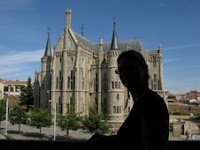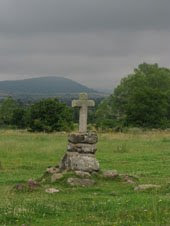 The first time I smelt crushed sap and realised that below my feet on the road's edge was green grass, I received the news like fresh water in the face: the Meseta was behind us.
The first time I smelt crushed sap and realised that below my feet on the road's edge was green grass, I received the news like fresh water in the face: the Meseta was behind us.Much still masqueraded as the Meseta. A straight and flat seven kilometres of road ended only when a sign announced a right-angle bend and warned local joy-riders to slow. Yet water gushed in the irrigation channels beside us to exit via sluices into small fields of tobacco and spinach. We even saw cows grazing, like a memory from a distant land. Each ditch fringed with bulrushes was a universe of shoals of tiny fish, startled frogs and mating dragonflies. The world returned to life where the fringes of the Montes do León mountains meet the upland plain.
As we walk towards Astorga those mountains which had been distant mirages easily
 confused with the purple clouds finally reveal their slopes of chestnut forest and cropped fields through which we can pick out the line of a road. In a day or two we will be there, in the Margaratería.
confused with the purple clouds finally reveal their slopes of chestnut forest and cropped fields through which we can pick out the line of a road. In a day or two we will be there, in the Margaratería.But for tonight we are in fantasy land. Every shop lining the main streets and squares of Astorga sells chocolate. Great slabs of the stuff are wrapped in old-fashioned block-printed paper that makes buying it seem a virtue of traditional values rather than a sin. Beside the chocolate are pick 'n' mix mountains of handcrafted truffles and beside them, golden pillows of the feathery sponge cakes called mantecadas.
We head for the three-roomed chocolate museum and study each grinding stone, wooden mould and metal advert with care. We read the stories on the card collections that used to come with bars of chocolate and laugh at the severe family photos of the local chocolate dynasties. One room is given over the the lithograph stones used to print the irresistible wrappers.
 The "museum shop" is a simple wooden counter with a couple of dozen baskets of chocolate squares: chocolate from different countries and of different intensities. You could sample and compare to your stomach's content and the three attendants deep in their novels scarcely noticed. Our hundred grams of pure Tanzanian chocolate is a guilt (or is it gratitude?) purchase; and to avoid adding weight to our rucksacks we have to eat it in the evening sun, with the early-Gaudí, medieval-esque Bishop's Palace as a Disneyland backdrop.
The "museum shop" is a simple wooden counter with a couple of dozen baskets of chocolate squares: chocolate from different countries and of different intensities. You could sample and compare to your stomach's content and the three attendants deep in their novels scarcely noticed. Our hundred grams of pure Tanzanian chocolate is a guilt (or is it gratitude?) purchase; and to avoid adding weight to our rucksacks we have to eat it in the evening sun, with the early-Gaudí, medieval-esque Bishop's Palace as a Disneyland backdrop.17th September 2008





































































No comments:
Post a Comment